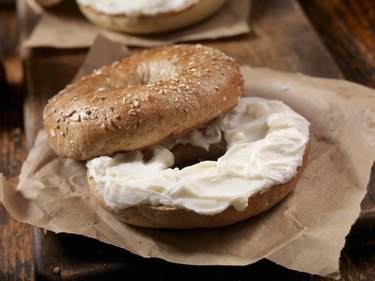Trying to Lose Weight? Here Are 5 Cheeses to Enjoy and 2 to Avoid

LauriPatterson/iStock/GettyImages
If you’re trying to lose weight, rest assured, you can keep your beloved cheese on the menu. Cheese often gets a bad rap because it’s high in fat, calories and sodium — and yes, it can be — but there are healthier cheeses to choose from.
In general, cheese provides protein, calcium, vitamin D and B12, and there are types of the gooey stuff that are lower in calories and fat — making them perfect for your weight-loss journey. The key is to keep your portions in check.
Video of the Day
Video of the Day
The USDA’s MyPlate recommends consuming two to three servings of dairy per day (this includes milk, yogurt and cheese). A serving of cheese is considered to be 1.5 ounces of hard cheese, one-third cup shredded cheese, 2 ounces of processed cheese, one-half cup ricotta cheese, or two cups of cottage cheese.
In general, here’s what to look for:
- A higher protein content: Its
protein offerings are part of what makes cheese ideal for weight loss. Protein
supports weight loss in a few ways, as outlined in an August 2012 article in the British Journal of Nutrition. The macronutrient is the most satiating
(compared to fat and carbs), it helps to retain lean muscle mass and it’s harder
for our bodies to digest, which helps us burn more energy. - Lower saturated fat content: We
don’t need to avoid all fat — our bodies actually need some fat — but
saturated fat is another story. Saturated fat raises your cholesterol, which
can lead to heart disease, according to the American Heart Association. When it comes to cheese, look for a low-fat
version or aim to keep your portions in check to keep your saturated fat intake
to a minimum. - A short ingredient list: OK,
any cheese you eat is going to be processed, but some types of cheeses have
been more heavily processed than others, and these are the types you want to
limit or avoid altogether. You can find some cheeses with just a few
ingredients like a milk source, salt and enzymes or cultures. Ultra-processed
foods may cause us to eat more, leading to weight gain, according to a May 2019
study in Cell Metabolism.
5 Cheeses to Enjoy When You’re Losing Weight
1. Cottage Cheese
Cottage cheese probably has one of the best calorie-to-protein ratios. In fact, a 1-cup serving has about 185 calories, 5 grams of fat and a whopping 23 grams of protein, per the United States Department of Agriculture.
What’s more, it pairs perfectly with other healthy foods like fresh fruit and vegetables. You can find it in low-fat, fat-free and regular, and there are some brands with reduced-sodium options, too.
2. Quark
Quark is a European-style cheese that looks and tastes more like Greek yogurt, although with less tartness.
It is among the lowest in calories and fat, with just 120 calories and 3 grams of saturated fat per 1-cup serving. It’s a good source of protein, too, providing 14 grams per serving. Overall, its nutritional offerings read more like yogurt versus cheese.
3. Swiss Cheese
A 1.5-ounce serving of our favorite hole-filled cheese provides 12 grams of satiating protein. It’s also extremely low in sodium, with less than 80 milligrams per serving, while other cheeses like feta and cottage cheese have upwards of 400 or 500 milligrams, respectively.
It’s also one of the highest in vitamin B12, providing more than 50 percent of your daily needs. This is a crucial vitamin because it helps keep all of our nerve and blood cells healthy. Plus, a deficiency in the vitamin can leave you feeling tired and weak, per Harvard Health Publishing.
Swiss cheese is also a popular fermented cheese, which means it contains gut-friendly bugs. It’s thought that carbon dioxide, which is released as part of this process, causes the holes or “eyes” in Swiss cheese, according to a March 2015 study in BioMed Research International.
4. Goat Cheese
Goat cheese is one of the lowest in calories, providing about 105 calories per 1.5 ounces. That comes with an ample amount of protein, too: 8 grams per serving.
But it appears it may be the fatty acids found in goat cheese that makes it so satiating.
An August 2017 Nutrients study found that goat cheese was more effective at suppressing appetite after eating compared to regular, cow’s milk-based cheese. The authors hypothesized it may be due to the types of fat found in goat milk products versus cow milk products.
5. Neufchâtel
There’s nothing like a fresh-baked bagel with schmear, but did you know there’s a healthier option than cream cheese? Neufchâtel cheese is lower in calories and fat and slightly higher in protein compared to regular cream cheese.
Neufchâtel cheese has about 30 percent fewer calories and total fat compared to the more commonly used cream cheese, according to the USDA. It’s also higher in bone-building calcium.
Ready to Lose Weight?
Set yourself up for success with LIVESTRONG.com’s Weight-Loss Kickstart program.
2 Cheeses to Avoid for Weight Loss
1. American Cheese
Did you know American cheese is not a type of cheese like Swiss or Brie — it’s actually a processed cheese product? You commonly find American cheese individually wrapped in plastic, and if you read the ingredients list, you’ll find it’s more cumbersome than most other cheeses.
It’s made up of ingredients like milk, cheddar cheese, whey, milk protein concentrate, milk fat, sodium citrate, salt, lactic acid, annatto and paprika, enzymes, cheese culture and vitamin D3. Aside from being heavily processed, it’s typically high in sodium, providing about 10 percent of your total needs for the day.
2. Nacho-Type Cheese
This type of ooey-gooey cheese is traditionally made up of a melted, highly processed cheese product. A 1.5-ounce serving of this stuff has about 105 calories, 3 grams of saturated fat and 6 grams of protein, which isn’t unhealthy from a numbers standpoint per se, but it’s extremely high in sodium — about 600 milligrams or 25 percent of your recommended daily intake.
Worse yet, we often pair this type of cheese with salty nacho chips made from refined grains. Plus, it can be difficult to keep your portions in check when eating these types of ultra-processed foods.




